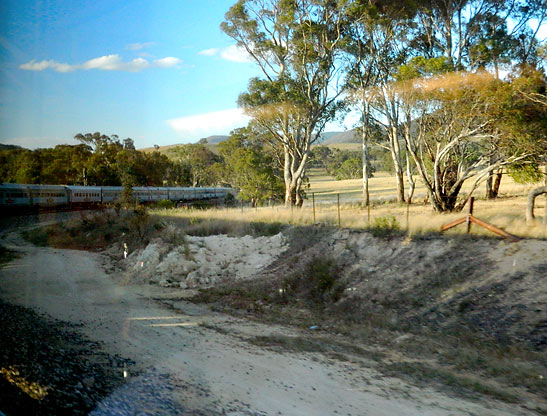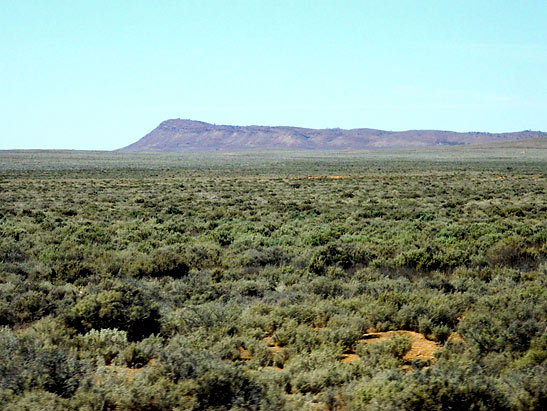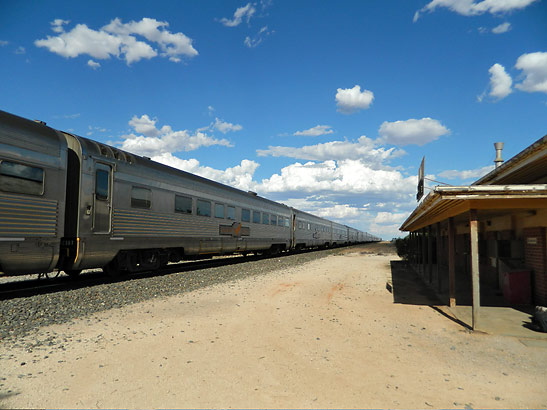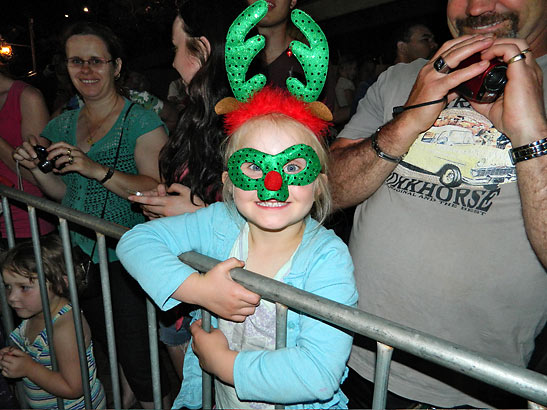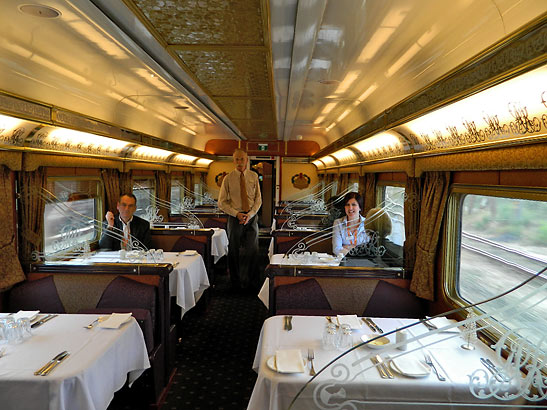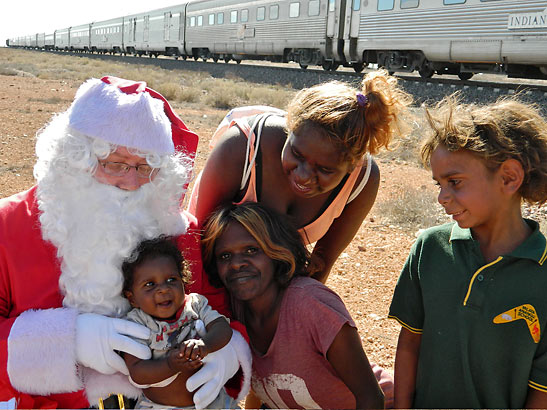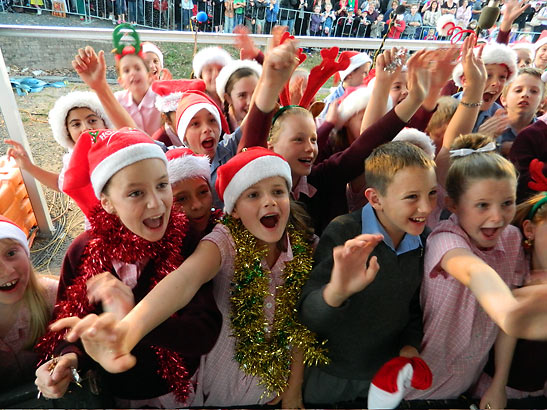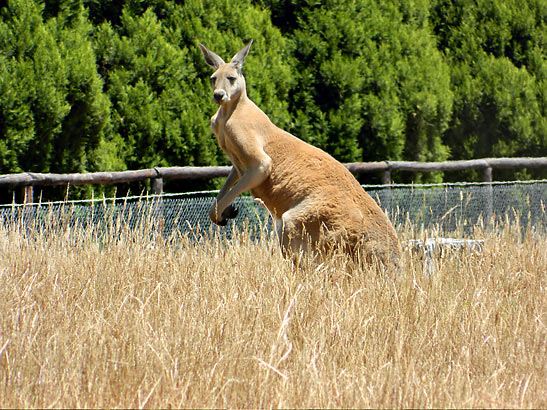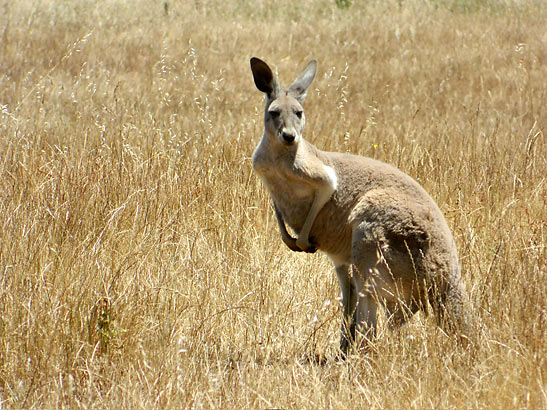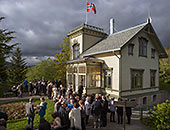 |
 |
|
 |

|
Rolling Through the Outback on
The Indian Pacific's Christmas Train
But we were cool, riding the air-conditioned Indian Pacific railway across the southern expanse of Australia to the west coast city of Perth, a four-day transcontinental tour through the vast, endlessly changing and sparsely populated plain of central Australia. The landscape took focus through the large windows on the train, beginning with the thick Eucalyptus canopy draped over the valleys and gorges of the Blue Mountains outside of Sydney through the undulating hills and farmlands of the Great Dividing Range and the starkness of the salt lakes and sand dunes of central South Australia.
Millions of stars revealed themselves in the pitch dark night skies, illuminating the wild and untouched, but wondrously and naturally manicured expanses, amazingly clean and as well laid out as a deliberately planted city park. The journey ended with a straight shot passage of rail, the longest in the world at about 300 miles, across the arid and infertile Nullarbor Plain and into the green zone of Perth on the west coast.
In addition to regular riders and vacationers, aboard the half-mile long train were 25 journalists, Brian McFadden, one of the country's top recording artists and a popular TV figure, and a well-known visitor from the North. We were on the Christmas Train, stopping in remote towns and railroad depots to bring Santa, toys and entertainment to the children and families that work the isolated ranches and mines in this great stretch of land.
The train was also raising awareness and funds for the Royal Flying Doctor Service which brings much needed medical care to remote areas of central Australia. TV stations had sent camera crews and there were newspaper and magazine reporters from all over Australia on board, along with a journalist from the London Times and yours truly, the sole American covering the annual event. The Indian Pacific journey ranges over 2,700 miles from coast to coast and began operating in 1970. The train is one of the great rails of the world with sleeping cars and wide windows that expose the magnificent vistas which unspool like a documentary film as you travel the country. The night was deafeningly quiet and the gentle rocking of the train encouraged deep sleep. Each berth had its own sink, toilet and shower facilities. Regular updates and travel commentary on the ever changing landscape were reported on the cabin speakers and optional music was also available. Along the way large groups of kangaroos and emus were visible through the windows as well as an occasional camel, lots of sheep and cattle, a menagerie of birds including galah, beautiful pink throated, white and grey feathered cockatoos, the magically fluting magpies with their enchanting songs, the joyous squawking of the starlings, and the trains logo, the wedge-tailed eagle soaring above the scorched earth with a massive seven-foot wingspan and an eye for native fauna as well, including rabbits and other small creatures that scuttled along the flat lands. Other welcome amenities on the train included the club lounge and dining car, the Queen Adelaide, where the drinks and gourmet meals were served. They were included in the travel package and enjoyed fully by the journalists, especially the club car, which was a favored site for imbibing and viewing. Chefs prepared the meals on board in the specially designed kitchens and seasoned staff served in elegant surroundings.
It's like train travel from an earlier, more gentile age. Costs range between $1,600 and $3,500 (the Australian dollar is on par with the American dollar) depending on the level of service. In the peak months of August to December there are two trains a week and about 70,000 ride the rails each year. Outside of Sydney, Adelaide and Perth, the Christmas train stopped in the town of Broken Hill, where children from the Assumption School sang Christmas carols with Brian then on to several tiny whistle stops in the Outback, including the town of Cook, with a population of four. Santa was greeted and known as "Ho Ho" in a remote stop near an indigenous settlement.
The last stop in the Outback was the mining town of Kalgoorlie, with a checkered history of dance halls and debauchery, but this year it provided the largest turnout on the tour. Along the way parents drove their children hundreds of miles to meet the train at the various depots to celebrate the holiday.
For information on the Christmas Train, the Indian Pacific and other rail tours available in Australia, from north to south as well as east to west, visit the Great Southern Rail website. Other locals:
* * * * * * * John Blanchette is a freelance travel writer, television producer and owns a public relations company in Santa Monica, California. Related Articles: |
|
Feedback for South of the Border Wine Country Hello John – I enjoyed reading your article. I live in
La Bufadora and have friends visiting next week, so you have given me some good
tips on where to go in our wine country. We have always called Cetto –
L.A. (like Los Angeles) Chet-o and it might have been worth mentioning that
it is actually Italian in origin. Also, I don't know about when visiting the
Valle, but when in town, it is better to have pesos than dollars. Right now
the rate is approx. 11.70 for each dollar. Just sayin' and like I said good
article!
Hi, We here at Country Living Magazine are working on a story about hotels around the US. We would like to feature the Paso Robles Inn. I have to find photos to go along with the story. I was wondering if you could please send me any images of the hotel. This can be anything from the rooms to the food! All images can be submitted low res and if selected I will ask for hi rez later. Also, if you know of any photographers that have photographed the hotel can you please give me the contact info? Thank you so much! --- Will Morel, Assistant Photo Editor, Country Living Magazine, New York, NY
I am looking forward to my "silver" years, which in my case, will be the years (if fate is good to me) that I will finally be traveling. New Zealand is at the top of the list - I have always been drawn to it. --- Sandra Mines, Seattle, WA
Yes, was a fun city. Bad wine though. --- Bo, Portland, OR
|
|
| |||
This site is designed and maintained by WYNK Marketing. Send all technical issues to: support@wynkmarketing.com

|






